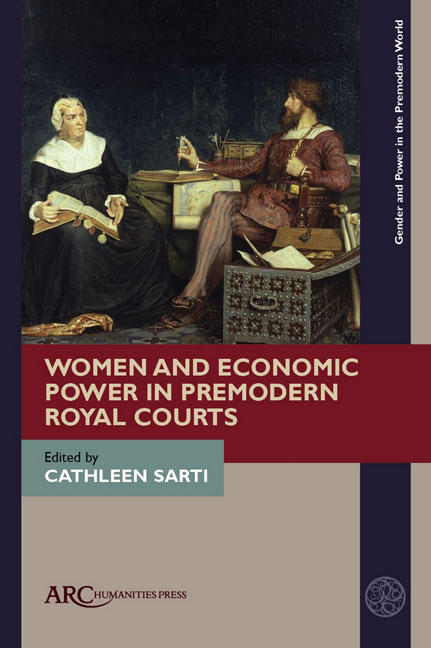Book contents
- Frontmatter
- Contents
- Acknowledgements
- Introduction: Women and Economic Power in Premodern Royal Courts
- 1 The Medieval English Queen as Landholder: Some Reflections on Sources and Methodology
- 2 Financial Power of Empresses and Princess Consorts of the Holy Roman Empire
- 3 “Edward III’s Gold-Digging Mistress”: Alice Perrers, Gender, and Financial Power at the English Royal Court, 1360– 1377
- 4 Counselling the Danish King: Sigbrit Villoms as Financial Mastermind for Christian II, 1513– 1523
- Afterword: “Power Is Money”? Reflections on Money, Power, Sex, and Gender in Premodern Royal Courts
- Bibliography
- Index of Persons and Topics
2 - Financial Power of Empresses and Princess Consorts of the Holy Roman Empire
Published online by Cambridge University Press: 20 November 2020
- Frontmatter
- Contents
- Acknowledgements
- Introduction: Women and Economic Power in Premodern Royal Courts
- 1 The Medieval English Queen as Landholder: Some Reflections on Sources and Methodology
- 2 Financial Power of Empresses and Princess Consorts of the Holy Roman Empire
- 3 “Edward III’s Gold-Digging Mistress”: Alice Perrers, Gender, and Financial Power at the English Royal Court, 1360– 1377
- 4 Counselling the Danish King: Sigbrit Villoms as Financial Mastermind for Christian II, 1513– 1523
- Afterword: “Power Is Money”? Reflections on Money, Power, Sex, and Gender in Premodern Royal Courts
- Bibliography
- Index of Persons and Topics
Summary
IN THE PAST decades, researchers of early modern history have considered the role of empresses and princess consorts of the Holy Roman Empire in the context of dynastic continuation (through the provision of heirs), dynastic and diplomatic relations, and cultural transfer. Whilst all important aspects of their role, what has received less attention is that empresses and princess consorts of the Holy Roman Empire also wielded considerable financial and economic power. Many received their wealth as part of their dowers or as presents from their husbands, but they were also usually heiresses who owned money, lands, and titles in their own right. This chapter addresses this lacuna in the current literature by analyzing the financial and economic power of empresses and princess consorts of the Holy Roman Empire across the early modern period. For this study, we are concerned solely with the wives of emperors and princes, rather than women who were princesses of the Holy Roman Empire by birth. The findings presented here are largely based on existing research and singular case studies which have been examined with a new focus on finance and economic power. It thus gives a starting point for further original research into the role of consorts as economic agents. This chapter presents an analysis of the financial role of several empresses or princess consorts, with a special concentration on one case study, Electress of the Palatinate Anna Maria Luisa de’ Medici (1667– 1743).
Marital status was key to these women's economic power. Empresses had, in addition to their own wealth, direct access to the emperor and to the imperial coffers, which they could use to support relatives and petitioners through gifts of money and land. The wife of an emperor was often the first point of contact for members of the natal families: the father of Empress Elisabeth Christine (1691– 1750, wife of Emperor Charles VI, r. 1711– 1740) heavily— and successfully— pressed his daughter for financial and feudal favours, even during times of extreme crisis for the Habsburg dynasty in the War of the Spanish Succession.
- Type
- Chapter
- Information
- Women and Economic Power in Premodern Royal Courts , pp. 35 - 58Publisher: Amsterdam University PressPrint publication year: 2020



